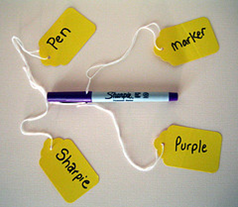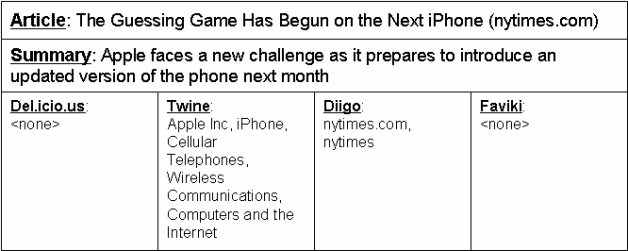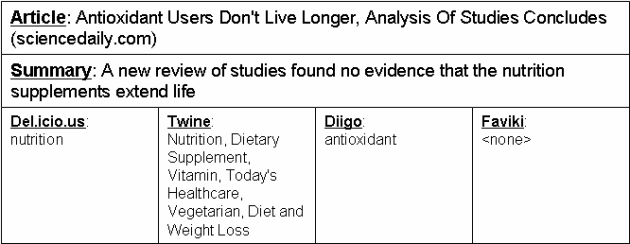Tag Recommendations for Content: Ready to Filter Noise?
May 27, 2008 9 Comments
In a recent post, I suggested that the semantic web might hold a solution for managing noise in social media. The semantic web can auto-generate tags for content, and these tags can be used to filter out subjects you don’t want to see.
As a follow-up, I wanted to see how four different services perform in terms of recommending tags for different content.
I’ve looked at the four services, each of which provide tag recommendations. Here they are, along with some information about how they approach their tag recommendations:
- del.icio.us: Popular tags are what other people have tagged this page as, and recommended tags are a combination of tags you have already used and tags that other people have used.
- Twine: Applies natural language processing and semantic indexing to just that data (via TechCrunch)
- Diigo: We’ll automatically analyze the page content and recommend suitable tags for you
- Faviki: Allows you to tag webpages you want to remember with Wikipedia terms.
Twine and Diigo take the initiaitve, and apply tags based on analyzing the content. del.icio.us and Faviki follow a crowdsourced approach, leveraging the previous tag work of members to provide recommendations.
Note that Faviki just opened its public beta. So it suffers from a lack of activity around content thus far. That will be noticed in the following analysis.
I ran the six articles through the four tagging services:
- The Guessing Game Has Begun on the Next iPhone – New York Times
- TiVo: The Gossip Girl of DVRs – Robert Seidman’s ‘TV by the Numbers’ blog
- Twitter! – TechCrunch
- Injury ‘bombshell’ hits Radcliffe – BBC Sport
- Why FriendFeed Is Disruptive: There’s Only 24 Hours in a Day – this blog
- Antioxidant Users Don’t Live Longer, Analysis Of Studies Concludes – Science Daily
The tag recommendations are below. Headline on the results? Recommendations appear to be a work in progress.
First, the New York Times iPhone article. Twine wins. Handily. At Diigo gave it a shot, but the nytimes tags really miss the mark. del.icio.us and Faviki weren’t even in the game.
Next, Robert Seidman’s post about Tivo. Twine comes up with several good tags. Diigo has something relevant. And again, del.icio.us and Faviki weren’t even in the game.
Now we get to the trick article, Michael Arrington’s no text blog entry Twitter! The table turn here. Twine comes up empty for the post. Based on the post’s presence on Techmeme and the 400+ comments on the blog post, a lot of people apparently bookmarked this post. This gives del.icio.us and Faviki something to work with, as seen below. And Diigo offers the single tag of…twitter!
Switching gears, this is a running-related article covering one of the top athletes in the world, Paula Radcliffe. Twine comes up the best here. Diigo manages “bombshell”…nice. del.icio.us and Faviki come up empty, presumably because no users bookmarked this article. And none of them could come up with tags of “running” or “marathon”.
I figured I’d run one of my own blog posts through this test. The post has been saved to del.icio.us a few times, so I figured there’d be something to work with there. Strangely, Twine comes up empty. Faviki…nuthin’.

Finally, I threw some science at the services. This article says that antioxidants don’t actually deliver what is promised. Twine comes up with a lot of tags, but misses the word “antioxidants”. Diigo only gets antioxidant. And someone must have bookmarked the article on del.icio.us, because it has a tag. Faviki…nada.
Conclusions
Twine clearly has the most advanced tag recommendation engine. It generates a bevy of tags. One thing I noticed between Twine and Diigo:
- Twine most often draws tags from the content
- Diigo more often draws tags from the title
Obviously my sample size isn’t statistically relevant, but I see that pattern in the above results.
The other thing to note is that these services do a really great job with auto-generating tags. For instance, the antioxidant article has 685 words. Both Twine and Diigo were able to come up with only what’s relevant out of all those words.
With del.icio.us and Faviki, if someone else hasn’t previously tagged the content, they don’t generate tags. Crowdsourced tagging – free form on del.icio.us, structured per Wikipedia on Faviki – still has a lot of value though. Nothing like human eyes assessing what an article is about. Faviki will get better with time and activity.
Note that both Twine and Diigo allow manually entered tags as well, getting the best of both auto-generated and human-generated.
When it comes to using tags as a way to filter noise in social media, both system- and human-generated tags will be needed.
- System-generated tags ensures some level of tagging for most new content. This is important in an app like FriendFeed, where new content is constantly streaming in.
- Human-generated tags pick up where the system leaves off. In the Paula Radcliffe example above, I’d expect people to use common sense tags like “running” and “marathon”.
The results of this simple test show the promise of tagging, and where the work lies ahead to create a robust semantic tagging system that could be used for noise control.
*****
See this item on FriendFeed: http://friendfeed.com/search?q=%22Tag+Recommendations+for+Content%3A+Ready+to+Filter+Noise%3F%22&public=1






Really good analysis there, much appreciated. I admit I’ve not heavily used any of those services in the past (and del.icio.us I just don’t like their site/interface).
But this kind of evaluation is invaluable. I posted on Twitter yesterday about how I’d worked out my time commitments in a day and realised quite how little time I had. Social networking takes up a chunk of that time. The more information on how best to network, and how to be effectively selective of sites to use, the better!
In the case of TiVo: The DVR of Gossip Girl’s Twine merely took the literal WordPress categories I assigned to that post. Interestingly,
We opted for a pretty streamlined category system for a variety of reasons and and have not yet played with the WordPress 2.5 “tags” at all. So far there is only one downside, though it is not insignificant: we lack any easy way to automate presentation of related content from our own site.
@Robin – thanks! I haven’t really looked at these services too much because frankly the use case wasn’t there for me. It’s hard to see a need for auto-generated tags out in the consumer Web (as opposed to the enterprise, where they serve more of a primary search & discovery purpose).
But the idea that there may be a way to handle the spigot of content intelligently before it hits your FriendFeed screen seems to be a compelling use case.
@Robert – interesting to note that Twine picked up on your blog categories. Our discussion continues on FriendFeed : http://tinyurl.com/6e7cqn
Pingback: WinExtra » From the Pipeline - 5.28.08
Pingback: Persuasive Picks for the week of 05/26/08 : PerkettPRsuasion - The PerkettPR Blog
Pingback: What a week we’ve had! « Faviki Blog
Pingback: Kaip teisingai dirbti su žymom ir temom? (I) | Aurimas Online
Pingback: I’ve Joined Connectbeam, and Social Media Got Me the Job « I’m Not Actually a Geek